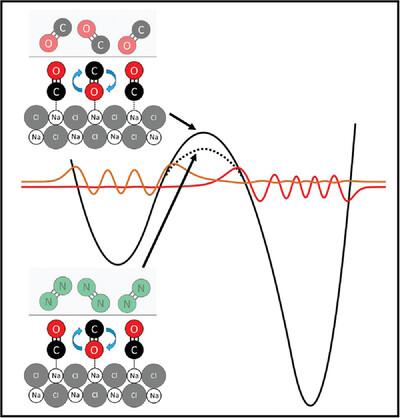Manipulating tunnelling gateways in condensed phase isomerization
IF 3.1
Q2 MULTIDISCIPLINARY SCIENCES
引用次数: 0
Abstract
When a chemical reaction occurs via tunnelling, a simple mass-dependence is expected, where substitution of atoms by heavier isotopes leads to a reduced reaction rate. However, as shown in a recent study of CO orientational isomerization at the NaCl(100) interface [Choudhury et al., Nature 612 , 691 (2022)], the lightest isotopologue need not exhibit the fastest tunnelling; for the CO/NaCl system, the non-monotonic mass-dependence is understood through a new picture of condensed phase tunnelling where the overall rate is dominated by a few pairs of reactant/product states. These state-pairs – termed quantum gateways – gain dynamical importance through accidentally-enhanced tunnelling probabilities, facilitated by a confluence of the energetic landscape underlying the reaction as well as the phonon bath of the surrounding medium. Here, we explore gateway tunnelling through measurements of the kinetic isotope effect (KIE) for CO isomerization in a monolayer buried by many layers of either CO or N 2 . With an N 2 overlayer, tunnelling rates are accelerated for all four isotopologues ( 12 C 16 O, 13 C 16 O, 12 C 18 O, and 13 C 18 O), but the degree of acceleration is isotopologue-specific and non-intuitively mass dependent. A one-dimensional tunnelling model involving an Eckart barrier cannot capture this behaviour. This reflects how a change to the potential energy surface moves states in and out of resonance, changing which tunnelling gateways can be accessed in the isomerization reaction.

在凝聚相异构化过程中操纵隧道通道
当一个化学反应通过隧穿发生时,一个简单的质量依赖是预期的,其中原子被较重的同位素取代导致反应速率降低。然而,最近一项关于NaCl(100)界面CO取向异构化的研究表明[Choudhury等人,Nature 612,691(2022)],最轻的同位素物不一定表现出最快的隧道作用;对于CO/NaCl体系,通过凝聚态隧穿的新图景来理解非单调的质量依赖关系,其中总速率由几对反应物/生成物状态主导。这些状态对——被称为量子网关——通过意外增强的隧穿概率获得动力学重要性,这是由反应背后的能量景观以及周围介质的声子池的汇合所促进的。在这里,我们通过测量被多层CO或n2埋藏的单层中CO异构化的动力学同位素效应(KIE)来探索通道隧道。在n2覆盖层下,所有4种同位素(12c16o、13c16o、12c18o和13c18o)的隧穿速率都加快了,但加速程度是同位素特异性的,与直观的质量无关。涉及埃卡特势垒的一维隧道模型无法捕捉到这种行为。这反映了势能面的变化如何使状态进入和退出共振,从而改变了异构化反应中可以进入的隧道通道。
本文章由计算机程序翻译,如有差异,请以英文原文为准。
求助全文
约1分钟内获得全文
求助全文

 求助内容:
求助内容: 应助结果提醒方式:
应助结果提醒方式:


